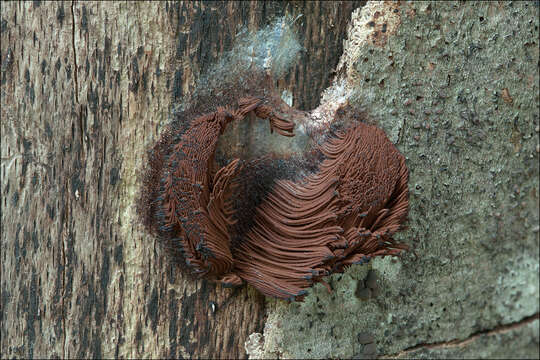Stemonitis-lignicola_16

Description:
Stemonitis lignicola Nann.-Bremek, syn.: Stemonitis splendens MorenoSlo.: no name.Dat.: July 20. 2016 - 19:47|Code: Bot_1075/2017_DSC8324Lat.: 46.35975 Long.: 13.70152Habitat: mixed wood, Fagus sylvatica dominant tree following by Picea abies; slightly inclined mountain slope, southeast aspect, old colluvial, calcareous, skeletal ground; in shade; relatively warm and dry place; partly protected from direct rain by tree canopies, average precipitation ~ 3.000 mm/year, average temperature 7-9 deg C, elevation 602 m (1.970 feet), alpine phytogeographical region. Substratum: old, cut off, standing trunk of Fagus sylvatica, partly debarked.Place: Lower Trenta valley, between villages Soa and Trenta, right bank of river Soa, next to the trail from Trenta 2b cottage to Strgulc abandoned farm house, Soa 48, East Julian Alps, Posoje, Slovenia EC. Comment: Stemonitis lignicola is generally considered a quite rare species. However, all macro and micro traits of this find as well as substratum fit well to Stemonitis lignicola descriptions in literature. An exception may be slightly large spores. However, the observed differences in diameter are roughly of the same size as between an example shown in Ref. 3 compared to average given in Ref.: 2. Capillitium extensions (resembling warts or free ends) were found rare and small. Note that Ref: 2 doesn't mention capillitium extensions at all and talks about smooth capilitial threads, while Ref.: 5 claims presence of capillitium extensions for this species.Sporocarps cylindrical, somewhat curved, about 12 mm high and 0.35-0.45 mm in diameter, stalks 2.5-3 mm long; surface capilitial net distinctive, uniform, small meshed, with rare extensions; capilitial internal net sparse, thick, with some membranous expansions; columella reaching the tip of sporocarps, gradually tapering toward the top, frequently bended in the upper part of the sporocarp; stalks short, blackish brown to black, shiny; hypothallus membranous, shiny; plasmodium white; spores on mass abundant, dark brown. Spores evenly, densely but minutely warty (verruculose); globose to subglobose. Dimensions: 7,9 [8,2 ; 8,3] 8,7 x 7,3 [7,8 ; 8] 8,4 microns; Q = [1 ; 1,07] 1,1; N = 36; C = 95%; Me = 8,3 x 7,9 microns; Qe = 1,1. Taken from dried material by gently tapping sporocarps. Average outer net (peridium) mesh 21 microns in diameter (SD=7 microns, N=30). Olympus CH20, NEA 100x/1.25, magnification 1.000 x, oil (spores), in water; NEA 10x/0.25, magnification 100x (capillitium, stalk); Bausch & Lomb, 4x/0.10, magnification 40x (capillitium). AmScope MA500 digital camera. Herbarium: Mycotheca and lichen herbarium (LJU-Li) of Slovenian Forestry Institute, Vena pot 2, Ljubljana, Index Herbariorum LJFRef.:(1) B. Ing, The Myxomycetes of Britain and Ireland,The Richmond Publ. Co.Ltd, (1999), p 203.(2) M. Poulain, M. Meyer, J. Borronet, Les Myxomycetes, FMBDS (2011), Vol.1., p 541.(3) M. Poulain, M. Meyer, J. Borronet, Les Myxomycetes, FMBDS (2011), Vol.2., p 538. (4) S. Behri, Raznolikost Pravih Sluzavk (Myxomycetes) v okolici Mengea, (in Slovene) (True Slime Molds (Myxomicetes) Diversity in Vicinity of Menge) (in Slovene), Graduation Thesis, University Studies, University in Ljubljana, Biotechnical Faculty, Biology department (2015), p 119. (5) H. Neubert, W. Nowotny, K. Baumann - H. Marx, Die Myxomyceten Deutschlands und des angrenzenden Alpenraumes unter besonderen Bercksichtigung sterreichs, Vol.3., Karlheinz Baumann Verlag, (2000), p 284.
Included On The Following Pages:
- Life (creatures)
- Cellular (cellular organisms)
- Eukaryota (eukaryotes)
- Amoebozoa (amoeboid protists)
- Evosea
- Eumycetozoa (slime molds)
- Myxogastria (plasmodial slime molds)
- Columellidia
- Stemonitida
- Stemonitidae
- Stemonitis
- Stemonitis lignicola
This image is not featured in any collections.
Source Information
- license
- cc-by-nc-sa
- copyright
- Amadej Trnkoczy
- photographer
- Amadej Trnkoczy
- original
- original media file
- visit source
- partner site
- Flickr Group
- ID


